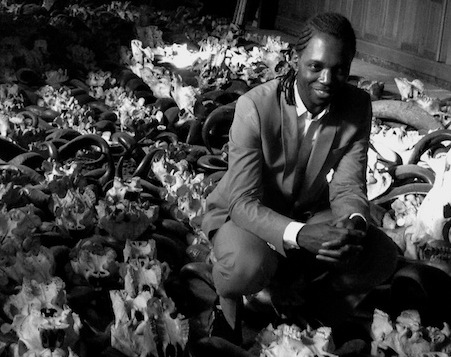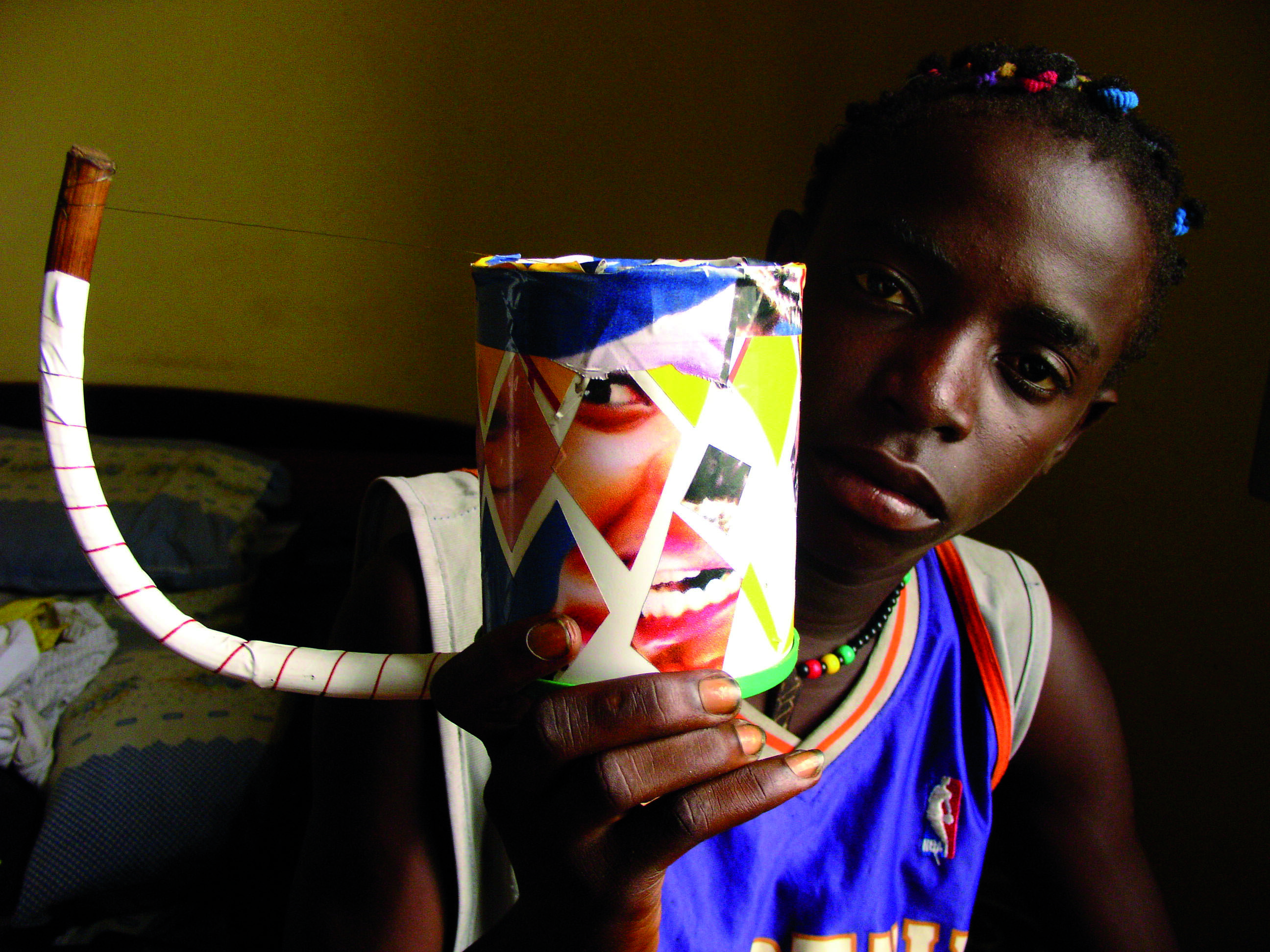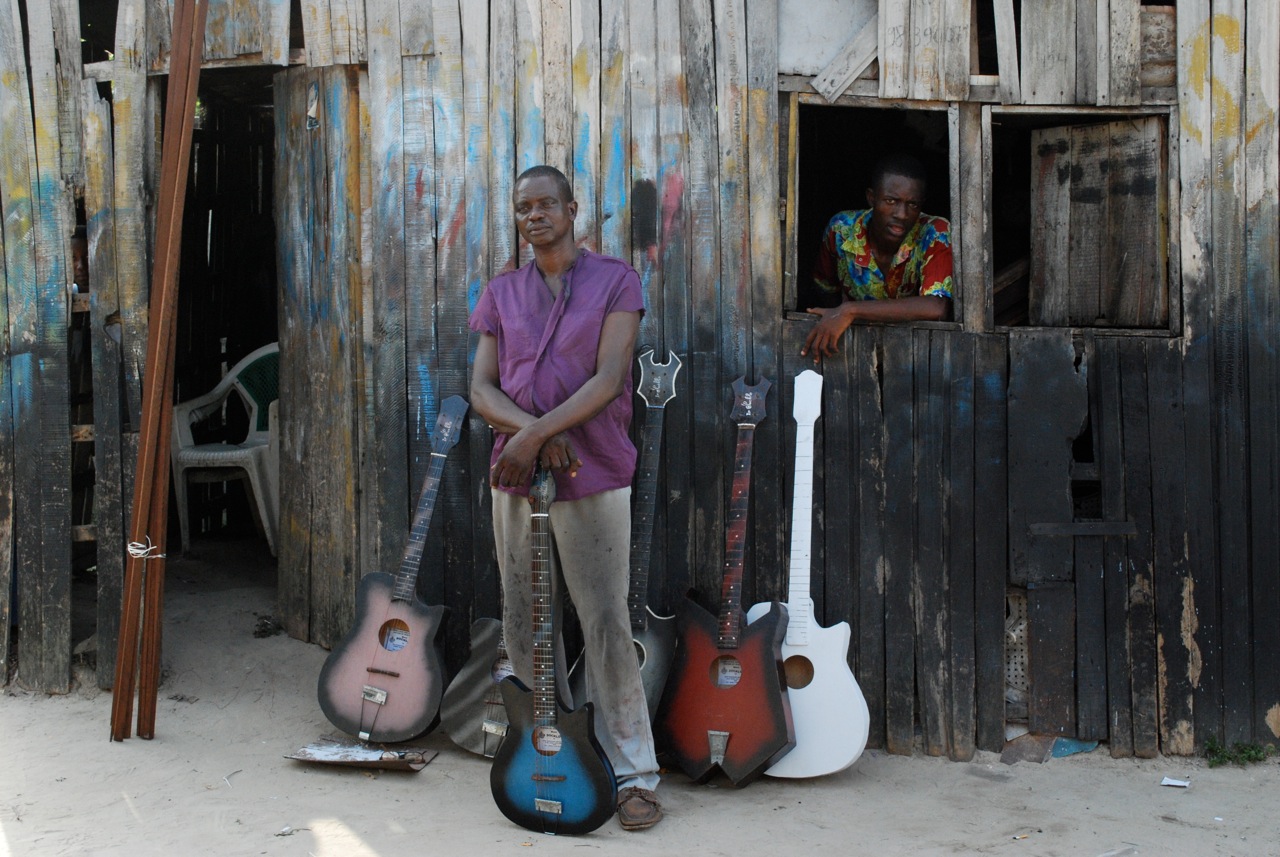This is an extract from a pamphlet / article / short book (fate will delete as applicable) that I’m writing about the Touareg blacksmith or artisan. It’s a complex subject and I’m approaching in my usual journalistic and non-academic way. This is bound to ruffle some scholarly feathers…an enjoyable sport in itself. I’m writing this piece for my wife Kate, who runs Saharan Arts, a company that imports Touareg jewellery and sells it on the internet or at UK Festivals like WOMAD and Latitude. Anybody who wants to know more, or buy a lovely present, please visit www.saharanarts.com. Enjoy…)
In the old days, the Touareg artisan blacksmith (enad sing., inedan pl.) lived towards the bottom of the social heap. His status wasn’t quite as lowly as that of the slaves (iklan) or even freed slaves (iderfan). But there’s no doubt that he was subservient to the warrior nobility (imajeren), the tribute paying vassals (imrhad) and the marabouts and judges (ineslemen). There’s an old Mauritanian proverb which says that the artisan must always be tah-ktab or tah-erkab, either under the power of the ‘book’, in other words, the holy man and his Qur’an, or under the ‘shield’, in other words, the noble warrior. Nevertheless, like most social relationships in this ancient feudal world, the artisan was tied to his superiors and inferiors by bonds of reciprocity that made each class indispensible to the survival of the whole. It was a supple system of give and take that gave society its unity, its strength and sinew.
The artisan made almost everything that was necessary for daily life and survival in the desert; tents, bags, saddles, swords, pottery, padlocks, keys, shields, lances, beds, musical instruments and, of course, jewellery. But his usefulness extended beyond that of a craftsman, a maker of objects. In fact, if you list every role ever attributed to the artisan class, you end up with an extraordinary array of trades and skills; jeweller, saddle-maker, leather-worker, carpenter, sword-maker, cobbler, potter, bead-maker, tanner, mat maker, teacher, historian, musician, nuptial negotiator or matchmaker, wedding organiser, midwife, messenger, diplomat, adviser, general repairman, knife-sharpener, circumciser, cattle-brander, hairdresser, surgeon, dentist, doctor, vet, apothecary…even magician!
Of course, no single artisan ever performed all these roles. To begin with, some of them were reserved for female artisans or tinedan, notably tent making, leatherworking and bead making. And there was also a hierarchy of activity within the artisan class itself. Jewellers were considered to be the masters, below them came the potters, then the woodworkers and so on. But it was not uncommon for a master jeweller to also be called on to fix a broken sword or saddle, pull a tooth, circumcise a young boy, take part in the negotiation of a wedding between the offspring of two noble families, or play music and recite epic poetry at some grand feast or event.
The most important characteristic of the artisans is that they belong to a hereditary ‘closed’ caste. You are born an artisan, you cannot become one. Your career choices are limited, albeit within the extraordinarily wide range of traditional artisan activity. Boys usually start their apprenticeship at around the age of seven, working the bellows while their fathers, uncles and elder brothers melt down and fashion the medial, tidying up around the workshop, making tea. After a few years the apprentice might be allowed to finish off a cross or a bangle, or make a very simple ring or earring. Gradually, after about fifteen years gradually ascending the hierarchy of skills he becomes a master artisan.
The artisans even had their own special language called Ténet. Nicolaisen concludes that Ténet is an invented language, like cockney rhyming-slang or Parisian verlan (backslang), which gave the artisans the means to communicate secretly in the presence of non-artisans, thus increasing their chances of boosting business and surviving. Most of the time the artisans spoke Tamashek, even when amongst their own family. Ténet seems to have been only an supplementary form of linguistic ‘armour’. Strangely, Gabus makes no mention of Ténet at all, stating merely that the artisans generally spoke too much, with lax manners of speech and a smaller vocabulary than the nobles.
In traditional society there were both nomadic and sedentary artisans. The nomadic artisan would live in the camp of a noble, vassal or marabout, travelling with them from pasture to pasture which his own family. They would make a huge number of goods and provide other services to their lord in return for protection, food, millet, milk, sugar, tea and clothing. He would also work for inhabitants of other camps in the vicinity, always in exchange for food and goods rather than money. His collection of tools was perforce small and easily portable from place to place. Gabus lists the usual barter price for different jewels, according to an artisan from the Hoggar region of southern Algeria:
A tchérot amulet pendant = 1 young camel
Two rings = one kid goat
A small padlock = one goat
A large padlock = two goats
A dagine style bracelet = two goats
A veil weight / padlock key = one goat
It is said that the nomadic artisans were generally less skilled, and their work was more basic and primitive than that of their sedentary counterparts, who lived in houses in towns like Boutilimit, Oualata, Timbuktu, Agadez, In-Gall and Tahoua. These Sahelian ‘ports’ were linked by trade routes to the sophisticated urban centres of North Africa, the Middle East and even Europe. New ideas, complex skills, tools, metals and other raw materials travelled with the caravans into the deepest Sahara via these trade routes and enriched the repertoire of the sedentary artisans. Out in the bush, the nomadic artisans lived a remoter and more isolated existence, and therefore found it harder to benefit from imported ways.
The origins and character of the artisan blacksmith.
The artisans themselves have their own set of poetic origin myths. They claim that their tools, especially their hammer, tongs and anvil were handed down to them by Father Adam and the Prophet David or Sidna Daouda taught them the dark art of iron smelting, and other less problematic skills like stone-cutting, moulding and engraving.
Other non-artisan members of desert society recount less charitable legends about the origins of the Kel Inedan. The great Jean Gabus was told the story that one day the Prophet Mohammed was bathing, and some children happened to see him. One of them mocked the Prophet and that wayward youth was the ancestor of the artisans. Another story he heard tells how the angel Gabriel asked Eve to show him her children so that they could be blessed. Eve dutifully brought out all her offspring except one, whom she hid away from the angel’s beatific gaze. That child was the ancestor of all artisans. In Mauretania, Gabus was also informed that the artisans took lessons in magic from the Ehel Belhamar or ‘People of the Devil’ so that they could protect themselves from the evil influence of the metals with which they were obliged to work.
Academics have searched for metaphorical truth in these myths and legends and some have come to the conclusion that the figure of Saint David proves the theory that the artisans are descended from Jewish jewellers from the Souss and Drâa valleys in the southern Atlas mountains or the Touat and M’zab regions north of Tamanrasset, all of which did have sizeable Jewish populations in the middle ages. It seems almost certain that some desert clans or tribes do have Jewish origins, notably the Kel Gress and the Daoussak (‘Sons of Issac’), and it must also be remembered that the whole of North Africa has ancient roots in Jewish culture, thanks to the Phoenicians and later cultures from the Levant who colonized most of the Mediterranean littoral before and during the days of the Roman empire.
However, the theory that all Touareg artisans are descended from Jews who came down from the north is tenuous. What is most striking about many Inedan is their Negroid appearance, or rather, their completely distinct physiognomy, in which Negroid traces are often very clear. A Touareg can identify an artisan merely from his facial features, even if he comes from a region thousands of miles away across the desert. This has lead to speculation that the Inedan are descended from an ancient black race who lived in the desert before the Berber tribes of the north came south and who were subsequently subdued and forced to work for their new ‘whiter’ overlords.
At times the assertion that the craftsmen who make such beautiful and sophisticated jewellery could only be descended from Jews or maybe Arab jewellers who came to the desert from Cairo and Baghdad in the early middle ages, smacks of mild racism and a reprehensible disbelief that such artistry can have its roots in black Africa itself. But if you consider the extremely sophisticated societies that existed in sub-Saharan West Africa, from the end of the Roman Empire right through to the 17th century, such as the Ghana, Mali and Songhai Empires, all famously rich in gold, as well as the extraordinary bronzes that were produced over 900 years ago in the Yoruban city of Ifé, in modern day Benin, using precisely the same lost wax technique that the Touareg artisans employ to make their famous crosses, then it seems perfectly possible that the source of the artisan’s craft lies to the south, rather than to the north.
Helen Hagan champions yet another origin theory, which holds that the Inedan’s ancestors came from the Egypt, Nubia and Ethiopia in the east, that they had a red ochreish skin colour and that they were conquered by the fairer-skinned imajeren. It’s true that some Touareg bear a striking resemblance to native Americans, and that they are often referred to by their southern black neighbours as les peaux rouges, ‘the redskins’, but once again this theory is tenuous.
The fact is that all artisan origin theories are tenuous, and will probably remain so until same serious DNA ancestry-tracing work is done in the region. Despite the ‘closed’ endogamous nature of the artisan clan, I prefer to believe that a variety of different racial and cultural traits are bundled together in the modern-day Inedan. No doubt the skill and knowledge of Jewish jewellers from the Anti-Atlas and the Algerian plateaux did filter further south gradually over the centuries, no doubt grandees who travelled to the Sahara from Cairo, Jerusalem and Baghdad brought their own artisans with them, no doubt Berber craftsmen from the North travelled south in baggage trains of successive military conquerors, no doubt there were already considerable metal working skills amongst the black peoples of the Niger Rivers and since the Peulh or Fulani people who populate the whole of West Africa almost certainly came originally from what is now The Sudan and Ethiopia, there was probably a major influence from that region as well. What we probably have in the Touareg artisan of today is a mongrel racial and cultural mixture that has been created over centuries of Saharan interchange or brassage, as the French say.
Some further clues about the origins of the Kel Inedan can be wrung from the attitudes of Touareg society towards the artisan caste. Disdainful, mistrustful, fearful and mildly racist, these attitudes are a remarkable echo of baser cultural prejudices in our own society, especially towards Jews, Gypsies, immigrants and manual labourers. The litany of derogation that appears in the academic studies makes for potent reading. In the eyes of decent Touareg society, the artisans are crafty, mischievous, lazy, greedy, indiscreet, loose-tongued, ill mannered, badly dressed, duplicitous, untrustworthy, stupid, in league with evil spirits and tangled up with dark magic.
I remember chatting with some Touareg friends about a common acquaintance of ours who had apparently embezzled a small sum of money. “What do you expect,” one of my friends said without the slightest shadow of shame or embarrassment. “He’s a fourgeron (a blacksmith)!” The man whose reputation was thus being sullied came from the artisan caste, but wasn’t in fact involved in any of the traditional artisan activities. He was a driver, car-mechanic and odd-jobber. My friend flung this mild insult his way with no malice or rancour, and the artisan was back amongst us laughing and joking that very same evening. A subtext of the insult was that our artisan friend just couldn’t help who he was! It’s just the way he was born, and there was nothing that anyone, least of all the artisans themselves, could do about it. But it didn’t mean that the artisan was to be ostracized or rejected in any way.
The episode illustrates a very strange symbiotic relationship between the artisans and other Touareg. The majority image of the artisan mixes disdain, mistrust, fear with a kind of respect and dependency. If the artisan is descended from a conquered clan of aboriginal inhabitants who lived in the Sahara before the arrival of the Berber tribes from the north, then the disdain that Touareg society feels towards him is perhaps an echo of the original hauteur that the victor felt toward the vanquished. Perhaps their mistrust can be attributed to that universal contempt which dominant social groups feel towards subservient ones, especially if they are racially different and ‘closed’. Maybe this antipathy is also attributable to the natural arrogance of the warrior nobility towards those who depend on their manual labour for their livelihood. And perhaps the fear comes from a superstitious wonder at the ‘magic’ of metalworking, the fiery transformation of base raw materials that were once locked up inside soil and rocks into wondrous jewels, swords and other objects, using processes that are deeply entwined with very ancient, possibly animist, religious beliefs. One can almost picture the Berber lord shuddering, proud in his racial, cultural and religious superiority, as he looked down on the black animist metal-worker coaxing some wondrous object out of the primordial fire using mysterious and opaque gris-gris and evoking the names ancient and unknowable spirits. After all, this terror of those who work with fire, who mould and sublimate nature itself, is common amongst many early or pre-industrial societies.
But it’s the respect and licence given to the artisan, which makes their relationship with the rest of Touareg society so strange, even unique. Gabus recounts how artisans sometimes became the trusted friends and advisors of clan chiefs or other noble persons, and how they were often asked to go on delicate diplomatic missions, or to negotiate the bride price and dowry for an important wedding. Like the court-jesters of medieval Europe, the artisan was given much freer licence to express his own opinions in the presence of the rich and powerful than other members of society.
Paradoxically, the artisans were also deemed to be wise and knowledgeable, especially when it came to tribal and clan history or the useful properties of the natural world. They were respected for their extraordinary ability to produce all the good necessary for life in the desert, and their wide range of their skills and know-how. They were often prized for their loyalty and friendship. The very fact that they were not of a noble caste, and were therefore excluded from the politics and power-struggles of tribes and clans probably made their friendship less ‘dangerous’ and more secure than that of other clan members.
Like their counterparts south of the Niger, the griots of Manding, Songhai and Bamana society, the artisans were the repositories of society’s oral history and were excellent musicians. Nicolaisen tells how many noble Touareg despised and shunned Inedan for much of the time, except at weddings, feasts and ceremonies when the artisans were called on to sing and recite poetry and thereby oil the social machinery. Furthermore it was considered bad form to loose one’s temper with an artisan or his provocative words and extremely dishonourable to hit or wound one. In some ways, the artisan’s freedom to speak his mind was useful in as much as it could deflate potential conflict, thereby maintaining harmony and strengthening the equilibrium of the clan. And this free speech was more often that not softened and nuanced by a high degree of humour and hilarity. The comic genius of the Touareg is something that is very often ignored or overlooked by outsiders who fail to see beyond their characteristic haughtiness and reserve.
Gabus also claims that the artisans themselves were fully aware of and accepting of their own unique place in society. “An artisan who never asks for what he wants, or tries to get it, is worthless,” Gabus was told by an artisan. In other words, it was all about give and take. The artisan played a game of survival with his Touareg neighbours, providing them with their necessities, but remaining apart on an equal-but-different footing, accepting taunts and jibes in return for custom and grudging respect, earning the most he could for himself and his family with his keen sense of opportunity, his acute bargaining skills and his nose for a good deal.
Jewellery and the Artisan in the modern age
However timeless, anchored and ancient Touareg society might seem to the visitor who leaves the bustling frenzy of a European city and arrives in the apparently infinite calm of the Saharan bush, it is hard to overestimate the radical and painful changes that have gripped the desert in the last century. And these changes have also fundamentally affected the role and business of the artisan.
When Jean Gabus was carrying out his research in the 1940s and 1950s, he observed this changing world at first hand. The artisans were relying more and more on cash transactions and less and less on the old bartering system. In certain ways, cash freed the artisan, making him less indentured to his overlord and master higher up the Touareg hierarchy. The old tribal and clan chiefs, along with their noble retinues, were loosing influence year by year, thanks to the French ban on traditional raiding and the careful colonial management of inter-tribal conflicts. The French more or less ruled the desert through acquiescent Touareg chiefs, but this policy also weakened their reputation, at times making them appear little more than puppets and collaborators of the colonial power. The decrease in traditional inter-tribal warfare meant less demand for the once indispensible swords, daggers and lances, and the decreasing power of the nobility meant that the artisan was able to look further afield for his living.
Another new and strange activity was selling to foreigners and tourists, who were less conversant with the price of goods in the desert and therefore often happy to pay more for jewels and other mementoes than local people. Furthermore tourists have tastes that aren’t necessarily shared by locals, and this had already begun to skew the production choices which the artisans made. The raw materials also began to change. Purer silver became more easily available, as did better tools, procured via mail-order catalogues from France.
Local tastes and customs were also changing. The wearing of jewellery had always been relatively regulated in traditional society. What you wore depended on your sex, your marital status and your position in society. A young girl would receive a small ‘ear-drop’ earring at the shortly after birth. As she reached puberty she would be allowed tesabit bangles and ankelets, as well as all manner of beaded jewellery. When she started courting she would don a chatchat or celebra necklace, both of which were associated with young love and flirtation. A khomeissa pendant was more appropriate for a married woman, because of its associations with fertility and protection. The large triangular teraout pendants were often part of the bride price for a wedding, thereafter forming the centrepiece of a jewellery collection. ‘Lower’ caste women were wore relatively modest jewellery that was in no danger of upstaging that of their ‘superior’ caste peers.
Men were expected to wear jewellery in a sober and dignified fashion, especially if they were nobles. A silver, or silver and brass tchérot pendant around the neck and a few others adorning their tagelmoust or turban in addition or a tanfouk ring, with its red carnelian or agate stone which was deemed to help heal wounds and coagulate the blood, were the limits of ‘decent’ adornment. A boy would receive both his tagelmoust and his tchérot when entering puberty. They were the armoury of his manhood, and were solemnly passed down to him by his father or guardian. Qur’anic verses and other protective writings were also kept in leather pouches that hung around the necks of both men and women.
Furthermore, silver, or at worse silver and bronze, were the only acceptable metals in traditional jewellery making. Gold was proscribed by the Qur’an, especially as an adornment for men, and feared for its malicious properties. Iron was also believed to be imbued with dark and malevolent forces. Silver was pure, clean, holy, luminous and warm, like the heart of a true believer.
The Touareg have the same word for both silver and money: azrouf. In the pre-cash society that existed in the desert before independence, jewellery WAS money, and vice versa. Women literally wore their wealth, in the form of pendants, earrings, bracelets, earrings, rings, anklets and head adornments. Rings and crosses were sometimes just strung along a piece of leather and worn as a necklace. When it came to paying for something, one of these items could just be detached from the rest and handed over.
To a certain extent, jewellery still serves a variety of interlinked purposes; status symbol, public display of wealth, means of exchange, protection against evil spirits and mishaps, beauty enhancement and token of flirtation. But cash has taken the place of bartering except in the remotest parts of the desert. Moreover, along with many erstwhile nomads, most artisans have now relocated to towns and cities, often grouping together to form associations or trading cooperatives, which allow them to deal with modern bureaucracy, regulation and taxes.
The artisan’s clientele has also changed considerably. Mohammed from the Association Assaghan in Tamanrasset told me that 60% of his sales are now to tourists and visitors, and 40% to locals. As in days of old, the locals order their jewels, rather than buy from existing stock. They will go and see the artisan and discuss the exact specifications, size and materials of the piece they want to buy, pay a portion of the price up front and then the balance on delivery. The artisan must make sure that the quality of the work is of an acceptable standard, otherwise his client will refuse to pay the balance and demand his deposit back. Sometimes clients come in with existing jewels and ask the artisan to melt down the silver and refashion it into an entirely new piece.
The most cataclysmic upheavals in desert life took place in the 1970s and the first half of the 1980s, due to the terrible droughts that afflicted the entire southern Sahara in 1971 – 1974 and 1984 – 1985. The transformation of traditional society which had begun with the arrival of the French was accelerated a hundred-fold, as the animal herds died and pastoral nomadism became almost impossible. Many Touareg men and their families left the region of their birth, to begin new lives, with different allegiances and imperatives in other parts of the desert. It’s impossible to say how many jewels and heirlooms were sold during these dark and desperate days to pay for food or transport to a refugee camp or a different country. Gabus compares these old jewels to the piles of shoes, glasses or wristwatches in the photos taken in concentration camps during the Holocaust in Europe.
The wealthier Touareg who were able to seek refuge in the cities of North Africa, Nigeria and even the Middle East, returned with mutated values. Gold, which is more favoured in the Arab world than it is in traditional Berber societies, became more fashionable and desirable. Women, who had traditionally worn a sober mixture of dark blue and white robes, or shiny luxurious indigo on special occasions, adopted the multi-coloured fashions of Mauretania, Algeria, Libya or Burkina Faso, where many Touareg families took refuge during the worst parts of the famine. The old restrictions on the appropriate wearing of jewellery according to age and status began to fade and disappear.
It must be said that the artisans reacted to these changes with considerable ingenuity, resourcefulness, self-reliance and a fatalism that Europeans find hard to understand, but which is necessary psychological armour in times of hardship. God willed it all, and there was nothing more to be said. In the absence of the old symbiosis with his noble lord, and his exclusive mandate to manufacture all the objects necessary for desert existence, the artisan was faced between the stark choice of adapting to the new realities, or disappearing.
From the 1950s onwards boutiques began to appear in Tamanrasset, Agadez, Timbuktu and further afield, catering for the tourist trade and offering a wide range of jewellery, leatherwork, swords, saddles, padlocks, souvenirs and knickknacks. Today, almost any desert city or town of 5,000 inhabitants or more has its artisans’ association, usually with a purpose built premises in the centre of town with a showroom and a salesman or two conversant in English, French and German, at the very least.
Since the late 1970s the market for Touareg jewellery and crafts has become global. Many artisans’ associations will elect a trusted person to become an international representative and send him to Europe or North America with several suitcases laden down with stock for international retail clients. These same reps will attend international tourism and crafts fairs and exhibit their wares at museums and festivals. The number of shops and websites the world over offering Touareg jewellery has grown exponentially in the last two decades.
Thomas Seligman has written a detailed account of how the revered French fashion house Hermès commissioned Touareg artisans to make a range of silver clasps, buckles and other objects, as well as using Touareg motifs and designs across all manner of expensive fashion goods in the early 1990s. With the help of an intermediary facilitator and fixer called Jean Yves Brizot, Hermès even set up and funded an entire workshop of artisans in Agadez, which employed over thirty craftsmen for a number of years. Touareg jewellery, crafts and clothing have also been used by fashion designers such Jean-Paul Gautier, Gucci and Yves Saint Laurent for high-end photo shoots and as the inspiration for new ranges and models. Touareg chic is a good option for those western fashionistas who desire to ‘go ethnic’ and yet remain sober, minimal and elegant.
How easy and yet somehow futile it is to mourn the gradual loss of paradise. It’s a pastime that not only preoccupies the minds of westerners who come to the desert in search of some kind of pre-industrial ideal of human nobility but also, in an admittedly different way, the minds of the Touareg themselves, especially those over the age of 50. I have always been struck by the potency of nostalgia for the past in Touareg society. It’s as if the process of assimilation into the modern world has occurred so suddenly, so brutally and in such an unwarranted way that many older Touareg just can’t cope with it, and prefer to dream of bygone days when there was more water, more respect, more peace and more freedom. Things today are just kerzat kerzat, a comical piece of Tamashek slang meaning ‘shoddy’, ‘cheap’ and ‘worthless’.
The artisans, however, cannot afford to indulge regrets, even though they might still lurk deep inside. They know that survival is a matter of looking ahead, not backwards, of using cunning and instinct to find customers and make the goods that those customers want to buy, whether they’re desert dwellers or tourists browsing idly at shops or stalls in Mopti, Tamanrasset, Tangiers, Barcelona, Brussels, Paris, San Francisco or on the world wide web. An acute and unsentimental instinct for survival whatever context God provides has been hardwired into their mental circuitry
And it could be argued that this survival instinct has served Touareg culture better than many Touareg themselves realise. For it is in part thanks to the artisans that the skill, range and depth of Touareg crafts survive and even thrive when the social context that first gave birth to it has long been consigned to history. The ingenuity and resourcefulness of the artisans, their ability to travel and assume the role of desert ambassadors in far-flung parts of the world, their talent for dealing with strangers, their openness and autonomy have preserved the essence of the Touareg cultural identity, keeping it alive, vital, breathing and even growing. The Touareg owe their artisans a great deal.
Gabus expresses the misunderstandings and tensions of modernity very well, and remember, he was writing about the desert of the 1950s!:
“Preservation at all costs of the traditional heritage by means of a kind of isolation, of egotistical protectionism, false romanticism and backwards thinking bears no relation either to the desires, nor to the reality of the people themselves (the artisans). These people, like everyone else all over the world, dream of something other, want to earn money, live better and be in harmony with the times.”
Andy Morgan, (c) 2010










1 comment for “KEL INEDAN – The Touareg blacksmiths”